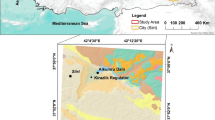Abstract
This paper describes the slope-instability processes and geological hazards affecting the historical site of Bamiyan, central Afghanistan, a major world-cultural heritage site. Here, two standing Buddhas carved in rock during the 2nd–4th centuries A.D. were destroyed by the Taliban in March 2001. There are very evident slope instabilities resulting from both explosions and natural processes: rock slides and rock falls had already occurred in the past and most areas are prone to collapse. Under the coordination of UNESCO, field data were collected and laboratory tests were performed to determine mechanisms for potential evolution of the cliff and niches. Areas of greatest instability, based on the field survey and data interpretation for both the small and great Buddha niches and surrounding cliff, were determined. This information helps to identify the most suitable method for restoration, in accord with the high cultural value of this site.
















Similar content being viewed by others
References
AGI (1977) Raccomandazioni sulla programmazione ed esecuzione delle indagini geognostiche. AGI, Milan
Amateur Seismic Centre (2003) Seismicity of Afghanistan. http://www.asc-india.org/seismic/afghanseis.htm#history
Ambrasey N, Bilham R (2003) Earthquakes in Afghanistan. Seismol Res Lett 74:107–123
ASTM (1977) Annual book of ASTM standards. Natural building stones: soil and rock– peats, mosses, and humus, Part 19. American Society for Testing Materials, W. Conshohochen, Pennsylvania
Barton N, Lien R, Lunde J (1974) Engineering classification of rock masses for the design of tunnel support. Rock Mech 6:183–286
Barton N, Bandis S, Bakhtar K (1985) Strength deformation and conductivity coupling of rock joints. Int J Rock Mech Min Sci 22(3):121–140
Beniawsky Z T (1989) Engineering rock mass classification. Wiley, New York
Brown G (1972) The X-ray identification and crystal structures of clay minerals (2nd edn). London Mineralogical Society (Clay Minerals Group), London
Crosta G (1998) Slake durability vs. ultrasonic treatment for rock durability determination. Int J Rock Mech Min Sci 35(6):815–824
Dupree X (2002) Bamiyan. University of Peshwar, Peshawar
Franklin JA, Chandra R (1972) The slake durability test. Int J Rock Mech Min Sci 9:325–341
Goldstein J, Newbury DE, Echlin P, Joy DC, Roming AD Jr, Lyman CE, Fiori C, Lifshin E (1992) Scanning electron microscopy and X-ray microanalysis: a text for biologists, materials scientists, and geologists, (2nd edn). Plenum, New York, 820 pp
Gruen A, Remondino R, Zhang L (2002) Reconstruction of the Great Buddha of Bamiyan, Afghanistan. http://www.photogrammetry.ethz.ch/research/bamiyan
Gruen A, Remondino R (2002) 3D reconstruction of the great Buddha of Bamiyan. http://www.photogrammetry.ethz.ch/research/bamiyan
Hoek E, Brown LW (1980) Empirical strength criterion for rock masses. J Geotech Eng 106(GT9):1013–1035
ISRM, International Society for Rock Mechanics (1981) Rock characterisation, testing and monitoring ISRM suggested methods. Pergamon, London
ITASCA Consulting Group (2000) Fast lagrangian analysis of continua vs. 4.0. Minneapolis, Minnesota
Le Roux A (1971) La lyophilisation technique We’tude des textures des marries et argiles Bull Liaison Lab Ponts Chaussees 55:27–28
Operational Climatic Data Summary (2002) http://www2.afccc.af.mil/ocds_mil/products
Pejon 0, Zuquette L (2002) Analysis of cyclic swelling of mudrocks. Eng Geol 67:97108
Shepard FP (1954) Nomenclature based on sand-silt-clay ratios J Sediment Petrol 24:151–158
Shi B, Wu Z, Inyang H, Chen J, Wang B (1999) Preparation of soil specimens for SEM analysis using freeze-cut-drying. Bull Eng Geol Environ 5(8):1–7
Taylor RK, Spears DA (1970) The breakdown of British coal measures rocks. Int J Rock Mech Min Sci 7:481–501
Turner K, Schuster R (1996) Landslides investigation and mitigation. Transportation Research Board, National Research Council, Special Report 247, Washington, DC
Zang PZ, Yang ZX, Gupta H K, Bhatia SC, Shedlock Kaye M (2002) Global Seismic Hazard Assessment Program (GSHAP) in continental Asia http://seismo.ethz.ch/gshap/eastasia/eastasia.html
Acknowledgments
The author expresses his gratitude to all the people who made this culturally important task possible. Logistics in Afghanistan were quite difficult; land mines were a terrible obstacle. The local UNESCO people provided excellent support: to mention Jim Williams is more than a simple acknowledgement. UNESCO Paris demonstrated once more their high professionalism in organising so difficult an assignment in such a perfect manner. Special thanks go to Christian Manhart as well as to Francois Langlois and Sarah Finke. The author expresses his gratitude to Prof. M. Pellegrini (University of Modena and Reggio Emilia) for many suggestions and continued encouragement, and Prof. Vittorio Colombini (University of Potenza) for great practical support. Many colleagues give their help and support in the laboratory investigation; it is a pleasure to thank Prof. Piero Manetti (Univeristy of Florence) for mineralogical and petrographic investigations, Prof. Renato Ribacchi and Prof. Tatian Tonda (University of Rome 1) for petrogeophysical investigations, Dr. Cinzia Crovato and Dr. Giovanna Armiento (ENEA) for X-ray analyses, Dr. Marcello Gioly Guidi and Mr. Fabrizio Pierdominici (ENEA) for scanning electronic microscopy. I also wish to thank my friends Dr. Giuseppe Delmonaco (ENEA) and Eng. Daniele Spizzichino (Consorzio Civita), who shared with me most of the brain storming and interpretation of the field data and laboratory tests. Last but not least, thanks to Dr. Mauri McSaveny, who reviewed the entire text providing very useful suggestions for the final version of the paper.
Author information
Authors and Affiliations
Corresponding author
Rights and permissions
About this article
Cite this article
Margottini, C. Instability and geotechnical problems of the Buddha niches and surrounding cliff in Bamiyan Valley, central Afghanistan. Landslides 1, 41–51 (2004). https://doi.org/10.1007/s10346-003-0010-0
Received:
Accepted:
Published:
Issue Date:
DOI: https://doi.org/10.1007/s10346-003-0010-0




